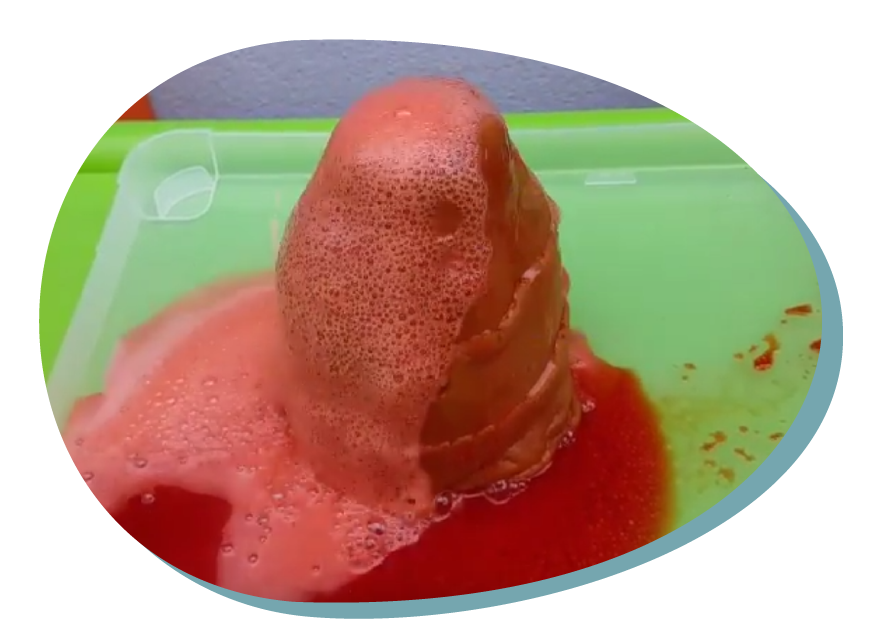The eruption in a bottle
Type of resource: website
Web address https://www.bimbicreativi.it/come-fare-un-vulcano-esperimento-per-bambini/
Language: EN
Description
Understand that the combination of bicarbonate and vinegar produces a chemical reaction, a gas called carbon dioxide.
Scientific concept introduced
Volcano, crater, eruption, lava, food colouring, bicarbonate, carbon dioxide.
Creative and critical thinking
Critical thinking:
– Analysis
– Observation
– Reflection
Creative thinking:
– Curiosity
– Amazement
Mathematical reasoning
Comparison of quantities
Scientific thinking
– Formulating hypotheses while watching the experiment
– Reproducing the experiment
– Evaluating the results
– Applying the results of the experiment to everyday life
Learning how to learn
– Ask yourself whether the same reaction can also take place with other ingredients and create various combinations, explain why this is not the case
Additional
– Actively participating in the teacher’s execution of the experiment
– Predicting possible results
– Becoming familiar with the ingredients
– Choosing the most suitable tools
– Concluding the activity with tidying up
The eruption in a bottle
Overall aims
Creating attention and interest in children
Follow the instructions for an experiment
Describe the stages of a job
Developing manual skills
Exploiting and performing a chemical reaction
Recognising changes in a substance
Getting children interested in the world of chemistry and introducing them to the study of elements found in nature.
Vocabulary – keywords should be understood
Volcano, crater, eruption, lava, food colouring, bicarbonate, carbon dioxide.
Expected learning outcomes (operational aims)
the child/student will be able to:
– Carrying out an experiment
– Recognising changes in a substance
– Carrying out a chemical reaction
– Telling the story of the experiment
the child/student will have developed the ability to:
– Exactly following the steps of a process
– Making scientific observations
– Describe the stages of a job
STEM skills – to which the learning unit is related to
CORE STEM SKILLS
Observe
Asking questions
Experiment
Analysing the results
ADDITIONAL SKILLS
Scientific observation
Listening and understanding
Teaching methodologies/activity outline
Introduction:
Show the children/young people the material they will need to carry out the experiment and say to them: “What do you think we will do with this material today?”
“The eruption in a bottle” is the name of the experiment we are going to carry out today.
The experiment will be used to recognise changes in a substance
Activities:
After explaining the experiment to the pupils, the teacher gives them all the materials needed to carry out the experiment and guides them through the activity.
Material:
A plastic bottle.
Adhesive tape.
Scissors.
A green envelope.
A plastic container to raise the “mountain” and to contain the liquid that will escape.
A funnel.
Vinegar.
Bicarbonate.
Red food colouring.
Instructions:
– Cover the bottle with a green envelope so that it takes on the appearance of a volcano.
– Then, using a pair of scissors, pierce the envelope to free the top of the bottle and secure everything with adhesive tape.
– Using a funnel, fill the bottle halfway with vinegar.
– Pour in the red food colouring and mix the ingredients
– Add two teaspoons of bicarbonate to the inside of the ‘crater’.
Conclusions:
This activity aims to make the most of chemical reactions that occur with certain elements that are easy to find in the home.
The ultimate goal is to arouse the children’s interest, but also to initiate them into the study of chemistry and the elements found in nature.
Assessment of learning
It is implemented through observation of the activity by the teacher who assesses pupils’ commitment and participation.
Equipment and materials to be used in learning unit (tools, ingredients etc)
A plastic bottle.
Adhesive tape
Scissors
An envelope
A plastic container
A funnel.
Vinegar
Bicarbonate
Food colouring
Kind of setting
Science laboratory
References – source
https://www.bimbicreativi.it/come-fare-un-vulcano-esperimento-per-bambini/
The eruption in a bottle
1. Usefulness for STEM education – integrating content of different disciplines
Cross-curricular character of the resource

The range of S-T-E-M subjects included

The presentation of possibilities of including artistic activities (STEAM approach)

2. Expected learning outcomes
Consistency (links) with preschool core curriculum

Communicativeness of description

3. Methodology of teaching
Clarity, communicativeness of instructions for teachers

Meaningful learning – using practical life problems

Original idea

The level of ease in implementing the methodology to preschool age children

The level of ease in preparing necessary ingredients, materials and equipment needed

4. Sustainability
Ecological characteristics of materials/ results

Supporting healthy eating habits

Low ecological footprint

Possibilities of inclusion (respecting cultural diversity and food intolerances)

5. Class management
Using differentiated forms of work – individual, team work etc.

Individual work

Team work

Whole group
6. Time management

Short activity (10-15 minutes)

Medium activity (20-30 minutes)

Long activity (1 hour or more)

Very long activity (1 day or more)
PDF: https://www.printfriendly.com/p/g/iAFjqC

